 Rusi Taleyarkhan with his table-top fusion equipment in a lab at Oak Ridge, Tennessee, where he conducted research before coming to Purdue.U.S. Department of Energy file photo/Lynn Freeny
Rusi Taleyarkhan with his table-top fusion equipment in a lab at Oak Ridge, Tennessee, where he conducted research before coming to Purdue.U.S. Department of Energy file photo/Lynn FreenyDogged by controversy, the idea of bubble fusion needed a boost - and in January this year it seemed to get it. Nuclear engineer Rusi Taleyarkhan, who originally reported the phenomenon in 2002, published fresh results1 that he claimed answered his critics and reaffirmed that energy can be generated by nuclear fusion taking place in bubbles.
But even as the media were enthusing over this apparent advance, questions were being raised about Taleyarkhan's research at Purdue University in West Lafayette, Indiana. Several of his colleagues there have revealed to Nature that their confidence in Taleyarkhan's work has been seriously dented since he assumed his full-time post in their department in 2004.
Faculty members Lefteri Tsoukalas and Tatjana Jevremovic, along with several others who do not wish to be named, say that they now seriously doubt the reality of the bubble-fusion effect. Since his arrival at the university, they say, Taleyarkhan has declined to share the raw data he claims to have obtained in successful experiments on shared equipment. The faculty members add that he has opposed publication of their own negative results and has removed the equipment on which they were trying to replicate his work. "I am very concerned," says Jevremovic.
Bubble fusion is not a crank idea. It is well established that under certain conditions sound waves can force bubbles in a liquid to collapse and produce very high concentrations of energy. The energies inside individual bubbles can get high enough to create a plasma in which fusion could occur. In 2002, Taleyarkhan claimed to have demonstrated this effect, generating energy by fusing the nuclei of deuterium, a heavier isotope of hydrogen, inside collapsing bubbles2, and followed it in 2004 with further positive results3.
But his results have been controversial from the start. When Science published Taleyarkhan's initial paper, three researchers who peer-reviewed the work took the unusual step of shedding their anonymity to criticize the journal's decision to publish4. The three - Seth Putterman of the University of California, Los Angeles, Ken Suslick of the University of Illinois at Urbana-Champaign and Lawrence Crum of the University of Washington in Seattle - argued that Taleyarkhan had not ruled out several potential sources of error in his paper.
Try, try again
Nevertheless, the prospect of a cheap and relatively clean source of energy saw large amounts of money allocated to attempts to repeat Taleyarkhan's work. The US Defense Advanced Research Projects Agency (DARPA) gave Putterman $800,000 to try to reproduce the results, although he has so far not succeeded. Impulse Devices, a company based in Grass Valley, California, that focuses on bubble fusion, claims to be putting at least $4 million into its efforts. And researchers in Argentina have tried to recreate the phenomenon and so far failed.
Tsoukalas, head of the School of Nuclear Engineering at Purdue, was also intrigued by the Science paper. "This school has long-standing expertise in fluid mechanics and radiation measurements," he says. "I thought we might reproduce the results and build an expertise in the field."
Tsoukalas led Jevremovic and five others in an effort to replicate bubble fusion. The team followed Taleyarkhan's published method, using acetone in which all the hydrogen atoms had been replaced by deuterium. The formation of bubbles was seeded by exposing the liquid to a source of neutrons, and sound waves were then passed through it to generate bubbles and collapse them. The team looked for radioactive tritium, one of the likely products from the fusion of two deuterium nuclei.
 Xu and Butt in a press photo distributed by Purdue University in July 2005.Credit: Purdue University
Xu and Butt in a press photo distributed by Purdue University in July 2005.Credit: Purdue UniversityIn late 2003, Tsoukalas managed to lure Taleyarkhan away from his position at Oak Ridge National Laboratory in Tennessee, and in the spring of 2004 Taleyarkhan arrived full-time at Purdue. By this time, the team had completed several experimental runs, but had not seen any evidence for bubble fusion.
Once Taleyarkhan had arrived, lab members became increasingly concerned by his actions. Jevremovic says that he would sometimes examine the equipment and claim that it was producing positive results, referring to an oscilloscope that he had. She says that she was uncertain about how the oscilloscope fitted into the experiment so she asked him for the raw data, but never received any. "He said: 'Look, there's a peak', but there was nothing to see," she says. "I started questioning it."
Now you see it...
Then one day, in or soon after May 2004, lab members arrived to find that Taleyarkhan had removed the experimental set-up from the communal lab, and taken it to his own lab off-campus. "I was really upset," says Jevremovic, who had been planning further work with the equipment. Although Taleyarkhan had contributed some equipment, the removed apparatus was largely funded by Tsoukalas and his colleagues.
"This made it very difficult to triple-check our results," adds Tsoukalas. But he says a decision was made not to pursue the issue: "This was a newly arrived faculty member and we need an atmosphere of tolerance because that is good for creativity."
By January 2005, the other faculty members had prepared a paper on their negative results, but Taleyarkhan was vehemently against it being submitted for publication. Tsoukalas and the other co-authors acquiesced, partly because of scientific caution over reporting negative results too quickly - without their equipment they couldn't generate any more data - and partly to avoid a split in the faculty.
 BUBBLE FUSION SPECIAL REPORT Bubble fusion: silencing the hype Bubble bursts for table-top fusion A sound investment?© Getty
BUBBLE FUSION SPECIAL REPORT Bubble fusion: silencing the hype Bubble bursts for table-top fusion A sound investment?© GettyThe researchers were therefore particularly upset when, in July 2005, Taleyarkhan asked the press office at Purdue to issue a press release on "peer-reviewed" and "independent" results that were positive for bubble fusion. The claims raised serious concerns at Purdue because the paper in which the results appear was written by two members of Taleyarkhan's own lab: postdoc Yiban Xu and master's student Adam Butt5. Taleyarkhan's claim that there has been "independent confirmation" of his results is repeated in the first sentence of his recent paper in Physical Review Letters1.
Xu and Butt's paper was also not sent out for anonymous peer review, Nature has established - it was published in a special issue of Nuclear Engineering and Design that was co-edited by Taleyarkhan, and it was reviewed by Taleyarkhan's co-editor Günther Lohnert of the University of Stuttgart in Germany.
There are also concerns about the paper itself. It states that tritium was detected during experimental runs at one lab, before "the experiment had to be shifted to a new building off-campus". Xu confirms that the tritium data were taken using the equipment that Tsoukalas and Jevremovic were also working on before it was removed by Taleyarkhan. But Tsoukalas and his team maintain that they never saw any raw data from the equipment that corresponded to a positive signal. "Tritium counts were within one standard deviation of zero," says Tsoukalas.
The exact nature of the data cited by Xu is proving hard to pin down. Xu reported them again, a few months after they were published, when he submitted a paper to the 11th Topical Meeting on Nuclear Reactor Thermal-Hydraulics in Avignon, France. But this time the size of the variation in the radiation counts for the positive tritium runs had slightly decreased, whereas the average for the control runs had become slightly more negative.
ADVERTISEMENT
Butt, who arrived in Taleyarkhan's lab after the data were taken, has now officially left the lab and has declined to comment. Xu blames the discrepancies on errors that were caused when two analyses became accidentally mixed up, but says that he stands by the paper's conclusions. A slideshow by Taleyarkhan posted on the Internet also shows data from Xu's analysis, but in this case a text box has been moved to obscure a point corresponding to a negative experimental run. When Nature attempted to contact Taleyarkhan, he said by e-mail on 22 February that he expected to be very busy for the next ten days. He has not responded since to any questions put to him regarding the points raised in this article.
In light of the growing concerns over Taleyarkhan's work, and his repeated claims of positive results, Tsoukalas says that he and his colleagues have now decided to submit their negative results for publication. On 1 March their paper was with the journal Nuclear Technology and was being prepared for peer review.
Post a comment to this story by visiting our bubblefusionsimplyhot_ai.html">newsblog .
-
References
- Taleyarkhan R. P., et al. Phys. Rev. Lett., 96 . 034301(2006).
- Taleyarkhan R. P., et al. Science, 295 . 1868 - 1873 (2002). | Article | PubMed | ISI | ChemPort |
- Taleyarkhan R. P., et al. Phys. Rev. E , 69 . 036109 (2004).
- Putterman S. J., Crum L. A.& Suslick K. . preprint at www.arxiv.org/abs/cond-mat/0204065 (2002).
- Xu Y.& Butt A. . Nucl. Eng. Des., 235 . 1317 - 1324 (2005).
